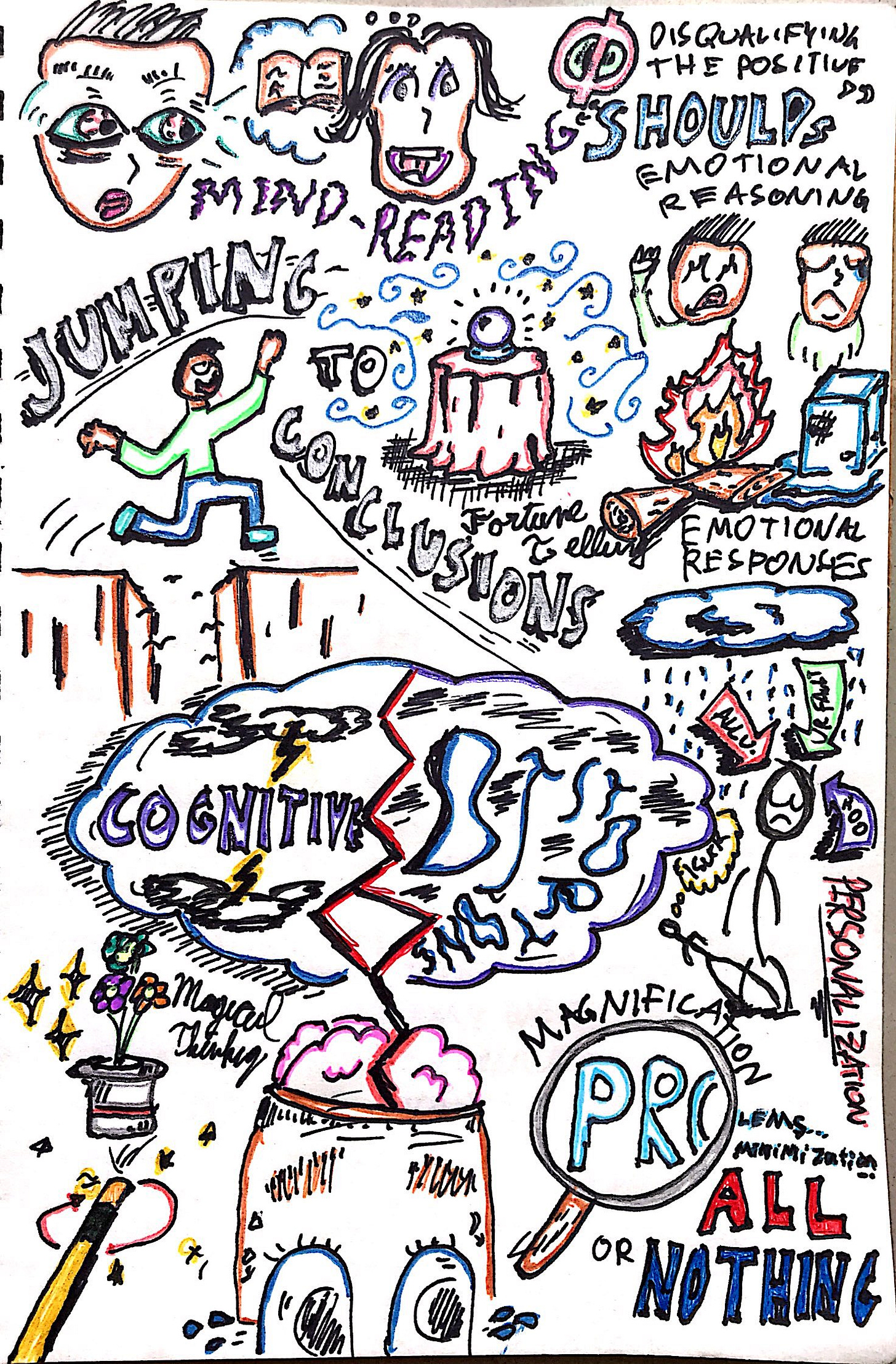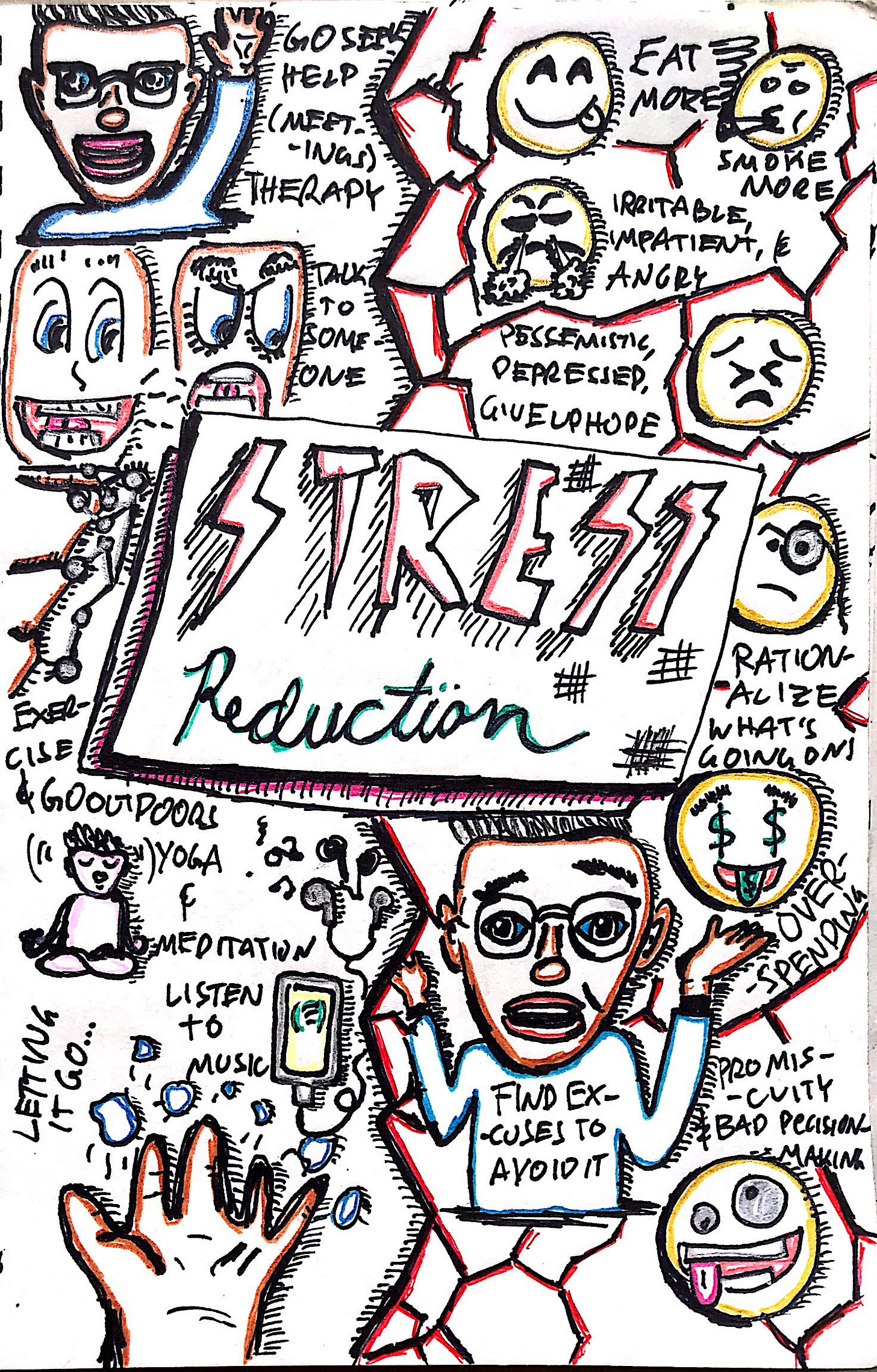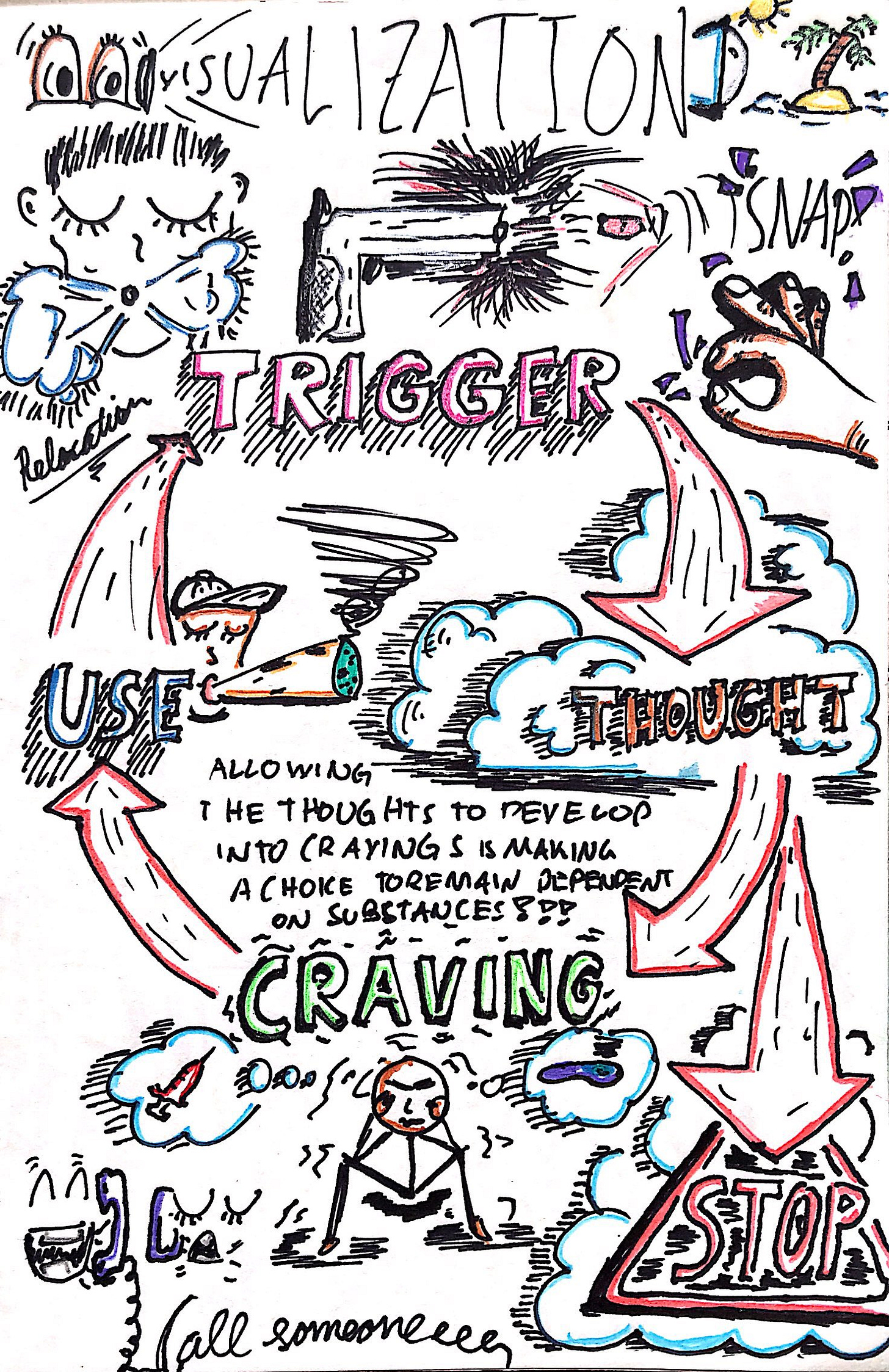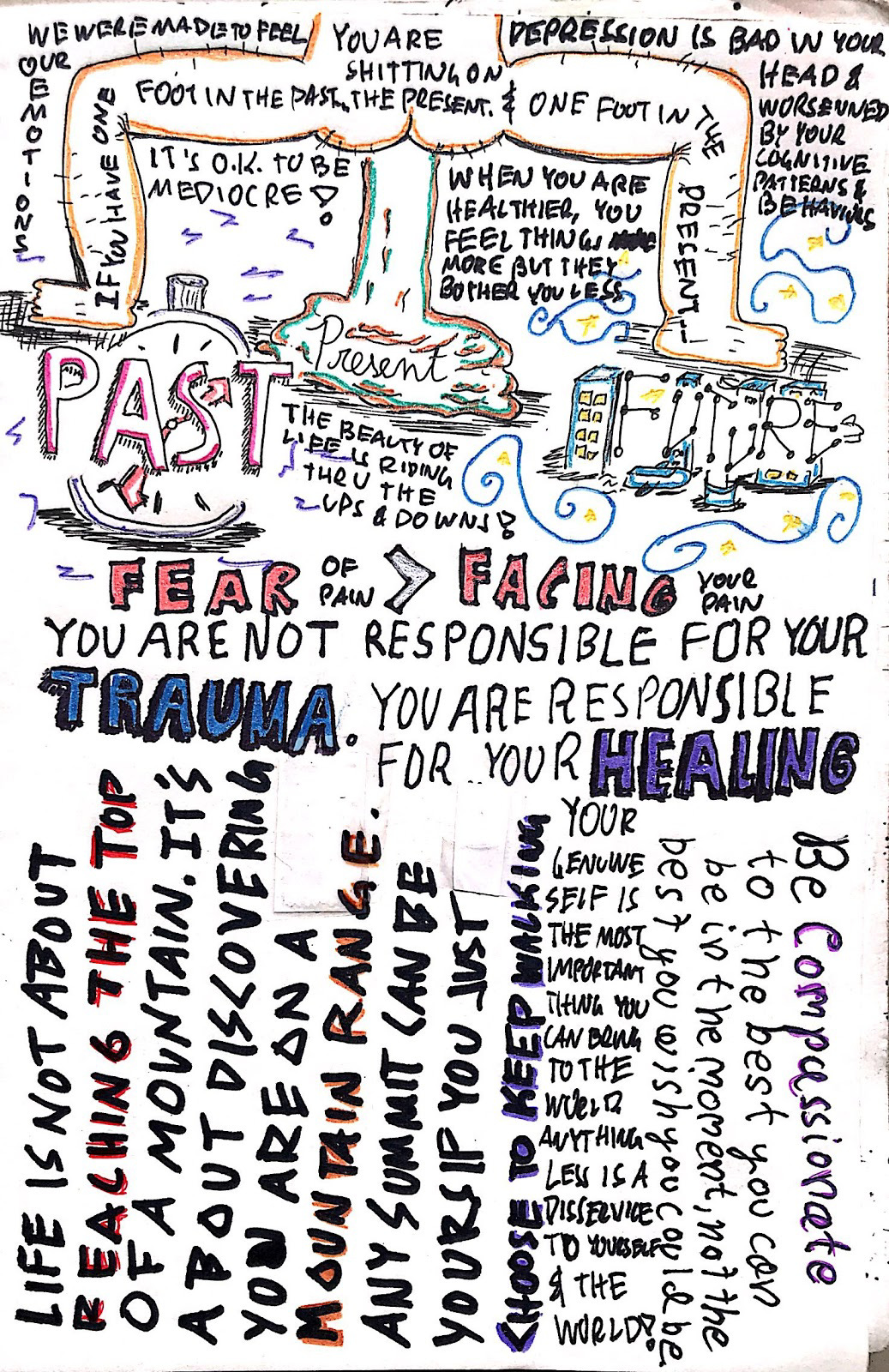
A zine of self-applicable mental health practices
What better way to start the new year off right than by making commitments to create practices to safeguard your mental health and your happiness. There’s a lot of threats to our sanity nowadays. Threats of war, climate change, and still the pressure to succeed and make something of yourself persist. It can be enough to drive one over the edge —God knows it almost killed me last year during my manic crisis in 2019.

But out of the diagnosis of Bipolar-1, hospitalization, and subsequent (and continuing) recovery through almost daily therapy I created this Zine: My Mental Health Matters. This zine contains and a summary of all the practices I learned in therapy. During therapy, I would doodle whatever we were learning for the day, manifesting into the con of my zine. They have been crucial in readjusting my worldview and becoming happier and healthier. I hope that they can be fun, entertaining, and educational too.
Each picture has an accompanying explanation to be used in supplication. Hopefully, you can get a sense of the essence of the lesson through both the explanations and the drawings. Click here to access the PDF version to carry with you or maybe even share it with a dear friend. To configure the folding, check out this how-to-make-a-zine for instructions.
Note: Note: It is always best to seek professional help regarding mental health troubles, but when these services are not accessible, your methods for self-care and self-soothing are crucial. These methods should be used in supplication but not a replacement for professional mental health help.
Do you have any mental health practices that you live by? Send me your favorite techniques and hit the share button below to share these resources with a friend.
Subscribe at The Activist Cookbook for more content on my dealings with my mental health and more! Also join The Activist Cookbook’s official Discord Server— The Kabayanihan—and let’s chat there!
My Mental Health Matters!

Cognitive Distortions — Page 3
What are Cognitive Distortions?
Cognitive Distortions are irrational thoughts in response to stressful events that can influence your emotions. By recognizing your cognitive distortions, you can challenge them and start to combat them with more rational thoughts. Below are some common cognitive distortions and my examples.
Jumping to Conclusions: Interpreting the meaning of a situation with little or no evidence. Irrational thought: “I’m not going to get the job because I’m underqualified. I haven’t done enough. I might as well not even apply for that job. Rational thought: “I might be underqualified, but I shouldn’t be the person to tell myself no. I’ll apply, and if I don’t get it, I know how to get better.”
Mind-Reading: Interpreting the thoughts and beliefs of others without adequate evidence. Irrational thought: “Oh no one at Vital wants to be friends with me. Look, no one is coming up to say hello to me. It must be because I’m Filipino or Gay. I’m just going to put my earbuds in and not talk to anyone. I don’t wanna get hurt.” Rational thought: “I’m a little nervous being here, and maybe people can see that and don’t say hi. I should try my best to be friendly, and accept it if I cannot at the moment.”
Fortune Telling: The expectation that a situation will turn out badly without adequate evidence. Irrational thought: “No one wants to be with me. All these dating apps are useless. Going out to meet people is useless. Why even try.” Rational thought: “Meeting people is a chance and opportunity. As tiring as it is, I must put myself out there if I wanna meet people and trust that it may or may not happen.”
Disqualifying the Positive: Recognizing only the negative aspects of a situation while ignoring the positive. Irrational thought: “Shortly after graduating from UCLA, I would say that I didn’t learn anything, that it was worthless. I would actively discount the amazing experiences I had and my statistics degree I earned.” Rational thought: “I gained an amazing education at UCLA. I graduated with a 3.5 in statistics. I was involved in the Filipino community and learned a tremendous amount about myself and my community. I trust the experience will build towards the future.”
“Should” Statements: The belief that things should be a certain way. Irrational thought: “I should only be happy, positive, and friendly to hang out with people. People don’t wanna be around me when I’m depressed. Better just stay in.” Rational thought: “Whether I’m depressed or manic, I am allowed to be myself in front of the people who truly care about me. The friends that are worth it will accept me for who I am.”
Emotional Reasoning: Assuming that just emotions reflect the way things are, whereas they only make one set of evidence of a situation. Irrational thought: “When I was depressed after graduating, I would feel like I had no friends. That all of the relationships that I had just evaporated into thin air. My friends weren’t my friends. No one truly wanted to be around me.” Rational thought: “I have no reason to think that my friends are no longer my friends. I’ll reach out, and if they don’t respond, then they don’t respond. I have no control over how they respond, just over how I do.”
Personalization: The belief that one is responsible for events outside of their control. Irrational thought: “It’s my fault that our relationship ended this way. If I was just a little better. If I could have been for you at that moment. If I just didn’t do this. If I just didn’t do that, then we could still be together.” Rational thought: “The construction and deconstruction of our relationship are complex. Yes, I made mistakes, but love is a two-way street; neither of us was in a healthy place to support a relationship. I take responsibility for how I contributed to our relationship’s demise.”
Magical Thinking: The belief that acts will influence unrelated situations. Irrational thought: “I’m a horrible person. I’m undeserving of love. I’m unworthy of affection. I suck as a person so no good things will come my way.” Rational thought: “I am a person who has done good and bad things. Regardless, I am deserving of love. At least I am deserving to try to put out and receive love.”
Magnification & Minimization: Exaggerating or minimizing the importance of events. Irrational thought: “Oh shoot, at work, I was late by 5 minutes. Every interaction means EVERYTHING. Don’t look them in the eye for too long. Laugh for just the right amount at their jokes. If you don’t you WILL get fired.” Rational thought: “Don’t sweat the small stuff. You can’t control every single action and your boss’ reaction. Just trust that you were hired for a reason.”
All or Nothing: Thinking in absolutes such as “always”, “never”, or “every”. Irrational thought: “I’m always so anxious around strangers if I’m not around friends. I should always be friendly and agreeable —a social butterfly my friends know I am. Why can’t I be social without my friends? Why am I so anxious?’ Rational thought: “I don’t always have to play the role of the social butterfly. I can be a silent observer. It’s ok to be silent and observational.

Stress Reduction — Page 4
Stress is an inevitable part of life. There will be good stress and bad stress. Avoiding it is impossible —trying to is dangerous. The only way to overcome stress is to learn how to manage it with coping mechanisms. Some coping mechanisms are unhealthy and in the long-run will exacerbate stress. Healthy coping mechanisms help reduce stress.
Unhealthy Coping Mechanisms
Overeating
Smoking & drug-use
Isolating yourself
Acting out in irritability, impatience, and anger
Sulking in pessimism and hopelessness
Rationalizing your emotions: using logic as a way to dismiss your stress or emotions
Overspending/overshopping: can sometimes manifest as “treating yourself”
Finding excuses to avoid stress
Sexual promiscuity and lowered risk-tolerance (engaging in more risky behaviors)
While we may sometimes rely on these to get through stress, it is best to avoid these forms of coping. But if you do use these to cope, always practice compassion on yourself. Don’t make your stress worse by stressing over your coping mechanism. Just acknowledge that you are coping unhealthily and move on.
Healthy Coping Mechanisms
Seeking professional help: support groups, alcoholics and narcotics anonymous groups, finding a therapist
Talking to a loved one
Exercising, going outdoors, taking a walk, distract yourself
Practicing yoga and meditation
Learning to let things go
Listening to music

Stress Reduction — Page 5
Self-soothing: Using your senses to reduce stress
Self-soothing utilizes mindfulness skills to reduce your stress. Self-soothing is a relaxation strategy where you utilize observation through your five senses, smell, sight, hearing, taste, and touch, to bring peace into your life. Your senses can trigger memories and make you feel a certain way. It’s important to observe these feelings deeply, intimately, and mindfully. Immerse yourself in your senses.
What experiences bring pleasure to your life? What sort of experiences do you relate with relaxation? Fun? Happiness? How do those experiences smell, look, hear, taste, or feel? If you are able, reduce your stress by breathing deep and observing your surroundings and using your senses? What are your most cherished senses? These are my examples:
Self-soothing Using Your Sense of Smell
Here are some smells that soothe me:
Burnt candles, sage, or essential oils
Baked goods, food, and restaurants
A local park & freshly mowed grass
The smell of my dogs after they have been showered
My bodily armpit smell
Self-soothing Using Your Sense of Vision
Observing parks, museums, or naturescapes
Drawing things
Pictures of my dog, family, and friends
Self-soothing Using Your Sense of Hearing
Listening to my favorite music
Audiobooks and podcasts
Soundscapes of nature or gongs
Soothing television that you can watch somewhat mindlessly
Walking outside and listening to sounds of nature
The sound of water running
Self-soothing Using Your Sense of Taste
Enjoying your favorite meal. Eat it slowly, savor and feel every bite
Lollipops, gum, or candy when you might feel stressed.
Drinking hot tea, hot water, hot chocolate. Slowly drink it to enjoy the way it tastes
Eating your favorite fruit
Self-soothing Using Your Sense of Touch
Textures: the feeling of clothes, trees, leather, wood, velvet, whatever is around me at the time
A hot and cold shower —the feeling of water splashing my face or a bubble bath
A massage or even a self-massage —rubbing my face, cheeks, eyelids, or eyebrows
Scratching my hair or my arms.
Playing with my dogs
Wearing my most favorite underwear and sweats
If you cannot remove yourself from a situation to find what soothes you, try to create tokens or memorabilia that incorporate your self-soothing observations. Make collages, collect smells, create playlists, keep food around, etc. You can fall back on these trinkets when you cannot leave the stress at the moment.

Anger Management & Reduction — Page 6
Understanding Anger
Physical Signs of Anger
Anger and frustration manifest physically as well as mentally. Biological signs of anger include the following:
Dilation of pupils
A stronger and faster heartbeat
Breathing becomes faster
Blood sugar increases to provide you energy
Digestion slows
Skin begins to perspire
Muscles tense
Understanding the biological signs of anger is integral to recognizing when you are angry.
Unhealthy Forms of Expressing Anger
Stuffing/repressing the anger: this occurs when one denies their anger and represses it. Ultimately, this only serves to let anger build up.
Delaying the anger: ignoring anger, conflicts, and responsibility does not make it go away. The feelings may eventually explode and result in worse repercussions if not dealt with right away.
Shifting the anger: shifting your anger from the primary target towards someone less threatening. An example is getting angry at a spouse because of a boss or exploding at a pet after a fight with your parents
Diluting the anger: this is weakening anger and pretending like it does not exist. Diluting anger is like trying to find excuses to not be angry.
Healthy Forms of Expressing Anger
Timeouts: simply, a timeout is taking a few deep breaths to respond before you react. I like to take a timeout whenever I am in a H.A.L.T. Any time I am feeling Hurried, Angry, Lazy, or Tired. Timeouts help take out the immediate reaction in the heat of the moment.
Relaxation through breathing and muscle relaxation: deep-breathing is a great relaxation technique. Focus on your breathing and take several deep breaths to try to release tension in your body. Try this practice: breath deep, and as you breathe out focus on releasing tension. Target different parts of the body with each breath.

Preventing Relapses into Substance Abuse — Page 7
Substance abuse is an unhealthy coping mechanism utilized by many addicts. While you may or may not identify as an addict, maybe there is a substance that you rely on when you are stressed. You can be addicted to drugs, but they can also include things people don’t generally think of —like sugar, carbs, unhealthy relationships, television, etc.
The Addiction Cycle
Trigger -> Thought -> Craving -> Use
Trigger: these are something that sets off a desire to use or act in a certain way. Triggers can include memories, smells, sights, emotions, friends or even families. Thought: experiencing a trigger will lead to the thought of using or abusing an action. Allowing thoughts to continue will lead to cravings which are the physical manifestation of the desire to use. Cravings can include sweats, physical salivation, stomach grumbling, etc. At the craving level, it is likely to result in use to satisfy the craving.
Coping with Abuse
The best method to break the cycle is to avoid triggers. While avoiding triggers is ideal, it is often impossible to do completely; so disrupting thoughts to prevent cravings is imperative. Once you allow thoughts to devolve into cravings, it is very hard to stop cravings from resulting in use. The idea is to shift your thoughts to something other than the substance or behavior. These are some techniques to cope with the addiction cycle.
Visualization: A form of meditation when you visualize a trigger and craving as something you can overcome. It also includes shifting your thoughts from the substance and trying to visualize something else.
Thought-Stopping: Finding ways to deter your mind from thinking about substance abuse from a trigger. These can include distractions like calling a friend, removing yourself from a situation, engaging in another activity, or even doing mental math in your head.
Relaxation through Breathing: Meditation and breathing can help distract from thoughts of using and instead redirect it towards observing and feeling your body.
Mga Pangaral, Lessons Learned — Page 8
Here are some of the lessons learned over the year. Some overheard and others I created myself. I hope they provide you peace and wisdom as they did for me.
If you have one foot in the past and the other in the future, then you shit on the present.
We were made to feel our emotions.
Depression is bad in your head & worsened by your cognitive patterns and behaviors.
When you are healthier, you feel things more but they bother you less.
It’s O.K. To be mediocre.
The beauty of life is riding through the ups and downs.
The fear of your pain is greater than facing your pain.
You are not responsible for your trauma, but you are responsible for your healing.
Life is not about reaching the top of a mountain. It’s about discovering you are on a mountain range. Any summit can be yours if you just choose to keep walking.
Your genuine self is the most important thing you can bring to the world. Anything less is a disservice to yourself and the world!
Be compassionate to the best you can be in the moment, not the best you wish you could be.



